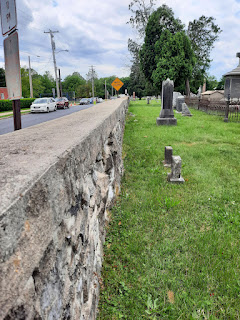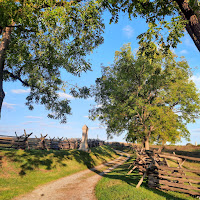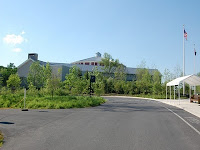 |
| The Molly Pitcher Monument |
Last week I posted about
Hannah Duston and her escape from the Indians. Another monument to a strong female historical figure is the Molly
Pitcher grave and statue in the
Old Public Graveyard in
Carlisle, Pennsylvania.
Molly Pitcher is one of those stories that can be filed under the heading of “
If
it ain’t true it outta be.” Of course, that’s my Texas heritage coming out. But
I’m convinced that there really is only one Molly Pitcher, her real name was
Mary Hays, and she’s buried in Carlisle.
Here's her story: During the American Revolution, Mary Hays
followed her husband, William Hays, to war, as a large number of women did. In
those days, women would follow the army to care for their soldier family members in
a variety of ways, like cooking, sewing, laundry, or assisting with medical
care. One other task these volunteers provided was bringing water to the
soldiers during training, or even during battle. These women earned the
nickname “Molly Pitcher.” Molly is a way of saying Mary, and Pitcher of course
is for the pitcher of water they’d carry.
 |
| The current monument is from 1916. |
William Hays enlisted in Proctor’s 4
th
Pennsylvania Artillery in 1777. Mary first went with the battery to
Valley Forge, then the next year to the
Battle of Monmouth Courthouse in New Jersey. This
is not disputed. During the battle, Mary was bringing water to the artillerymen
in her husband’s battery. When her husband fell, either from a wound or
heatstroke, Mary took over his job, using a ramrod to swab and load the canon.
Legend has it that during the battle she was seen working
with the gun’s crew by General George Washington. The General supposedly congratulated
her and made her a sergeant as a reward for her bravery. None of that can be
proven, although Mary reportedly went by the nickname “Sergeant Molly” for the
rest of her life. However, in 1830 a war veteran’s narrative was published that
described the incident of a woman taking over for her husband on an artillery piece during the Battle of Monmouth.
In it, the writer says that a British cannon ball passed between the woman’s
legs, tearing through her skirt but leaving her unharmed.
After the battle, Mary Hays and her husband returned to their
home in Carlisle, Pennsylvania. William Hays died in 1786. Mary later married
again, to a man named John McCauley. In 1822, Mary was granted a pension by the
state of Pennsylvania for her service. Mary died in 1832 and is buried in the
Old Public Graveyard as Mary McCauley. The current Molly Pitcher monument was
erected in 1916.
 |
Union troops were behind this wall
during a Civil War skirmish. |
There are a number of Molly Pitcher monuments. Some are in
the form of street names, murals, and even business names. I believe that Molly
Pitcher is a moniker given to women who followed their husbands to war during the
Revolution. Mary Hays is the personification of that. Much like
Rosie the Riveter was a name for women working in the defense industry during WWII and Naomi Parker was the inspiration for that. However, there is still controversy. You
can read
a Wikipedia article that does not question the existence of Molly
Pitcher. An
article on the American Battlefield Trust website, says that she is
a composite character, made up of the many Molly Pitchers. Yet finally, there
is
an article from Smithsonian that says she probably never existed.
If you ever get the chance to walk around Carlisle, please
do. Lots of history there from the Revolution to the Civil War. Take a look at
the Old Public Graveyard on South Street at Bedford. It’s an interesting place,
with the oldest burial from 1757. The east wall protected approximately 200 Union
soldiers when Jeb Stuart’s Confederate cavalry raided Carlisle during the Gettysburg Campaign. They traded shots with Confederate skirmishers who were
deployed in what would become Letort Park, on the other side of the creek. But
that’s a story for a future post.
 Last week (September 17th) was the 161st
anniversary of the Battle of Antietam. We have visited many times. Antietam, located
next to the small town of Sharpsburg, Maryland, is my favorite Civil War battlefield.
Antietam has historical significance in that the battle has a combined casualty
count of 22,727 killed, wounded, and missing. That makes Antietam (or
Sharpsburg to the Confederates) the highest one-day casualty count in American
military history. It was the impetus for Abraham Lincoln’s Emancipation
Proclamation, which changed the Federal cause for fighting the war from
preserving the Union to ending slavery. Moreover, it is an easy battlefield to
view the terrain and understand the flow of the battle. Climb the observation
tower. It’s worth it. And finally, the battlefield park is more than a park or
a tourist attraction. It’s hallowed ground where thousands of Americans fought
and died. That being said, Antietam is also a beautiful place to go for a walk and enjoy
the fall weather.
Last week (September 17th) was the 161st
anniversary of the Battle of Antietam. We have visited many times. Antietam, located
next to the small town of Sharpsburg, Maryland, is my favorite Civil War battlefield.
Antietam has historical significance in that the battle has a combined casualty
count of 22,727 killed, wounded, and missing. That makes Antietam (or
Sharpsburg to the Confederates) the highest one-day casualty count in American
military history. It was the impetus for Abraham Lincoln’s Emancipation
Proclamation, which changed the Federal cause for fighting the war from
preserving the Union to ending slavery. Moreover, it is an easy battlefield to
view the terrain and understand the flow of the battle. Climb the observation
tower. It’s worth it. And finally, the battlefield park is more than a park or
a tourist attraction. It’s hallowed ground where thousands of Americans fought
and died. That being said, Antietam is also a beautiful place to go for a walk and enjoy
the fall weather.Enjoy some pictures of the battlefield from our trip last Wednesday.
If you are looking for background on the Battle of Antietam, I have “Landscape Turned Red: The Battle of Antietam” by Stephen Sears on my shelf. Get out and
enjoy a historic site while the weather is nice. Maybe I’ll see you at Valley
Forge next week. 😉




























